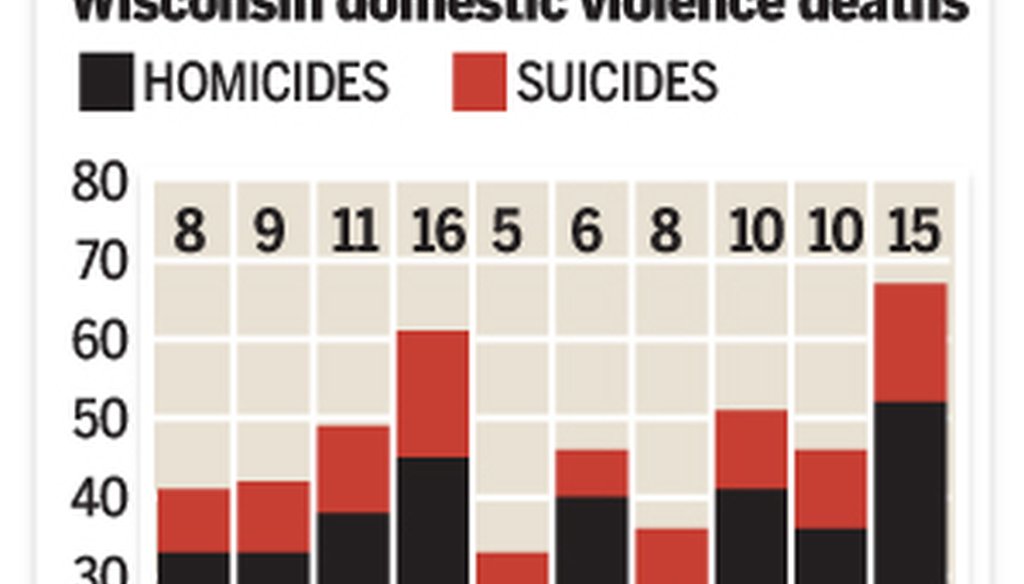

Our only agenda is to publish the truth so you can be an informed participant in democracy.
We need your help.


Here's a year-to-year tally of domestic violence-related deaths in Wisconsin, and how they would tally if suicides were not included
When U.S. Rep. Gwen Moore (D-Wis.) was honored by the National Network to End Domestic Violence, she issued a statement saying "we have a real crisis on our hands."
In Wisconsin, her Oct. 7, 2010, statement read, "deaths from domestic violence are at the highest in 10 years."
Indeed, eight days earlier, the Wisconsin Coalition Against Domestic Violence released a report that made that claim.
According to her spokesman, Moore based her statement on a Milwaukee Journal Sentinel article about the report. The article said domestic violence "claimed 67 lives" in 2009.
We wondered: Does that mean domestic abusers killed 67 people? And is that number, as Moore claimed, a 10-year high?
The Wisconsin Coalition Against Domestic Violence, like the national organization that honored Moore, is an advocacy group committed to ending domestic violence. It has produced a "domestic violence homicide report" each year since 2000, using data from crime report summaries from local police agencies and from various news articles.
The coalition defines homicide as "the killing of one human being by another."
But its annual homicide reports actually count more than that.
As in previous years, the 67 deaths in the 2009 report included homicides in commonly understood domestic violence cases -- such as when the victims and perpetrators were spouses or partners, former spouses or partners, or adults with children in common.
Homicides of other people are counted if, for example, a woman’s current boyfriend kills the woman’s former boyfriend; if a third person trying to protect a domestic violence victim kills the perpetrator; or if the domestic violence victim kills the perpetrator in self-defense.
But the Wisconsin coalition -- as it clearly notes in its report -- also adds suicides committed by domestic violence perpetrators. For example, it counts the January 2009 death of a Fond du Lac County man who took his own life after shooting his wife to death outside their home.
All told, the coalition says that in 2009, "there were 47 domestic violence homicide incidents resulting in 67 deaths -- 52 homicides and 15 perpetrator suicides."
Many people would not consider a domestic violence perpetrator who committed suicide to be a domestic violence victim. The coalition says it has always included perpetrator suicides in its annual tallies because they occurred as a result of a domestic violence incident, said spokesman Tony Gibart.
By the coalition’s count, the 67 total deaths in 2009 was the highest in 10 years, exceeding the previous high of 61 in 2003.
Excluding the suicides, the 52 other domestic violence homicides also were the highest in 10 years, exceeding the previous high of 45 in 2003.
So, Moore accurately quoted the group’s statistics, and those statistics have been consistently handled -- even though including the suicides increases the number.
We checked a few other states for how they tally domestic violence deaths:
"There’s no national standard way of reporting" domestic violence deaths, but counting perpetrator suicides is not common, said Shellene Johnson, the Minnesota coalition’s program manager.
We also asked a state agency, the Wisconsin Office of Justice Assistance, if there are official statistics on domestic violence deaths.
The answer is, not exactly.
Homicides tracked by the office are not identified in terms of whether they were the result of domestic violence, and suicides are not tracked at all. The office can infer which homicides were domestic, based on the relationship between the offender and the victim as recorded in police reports, said spokeswoman Tami Jackson. But unlike the Wisconsin Coalition Against Domestic Violence, the office does not look more closely into the circumstances of the deaths, she said.
That brings us back to Moore’s claim.
The Milwaukee congresswoman said deaths in Wisconsin from domestic violence "are at the highest in 10 years." Moore accurately quoted statistics compiled by an advocacy group for 2009. It’s important to note the group includes suicides committed by domestic violence perpetrators, which makes the death tally higher than it would otherwise be. Even so, either way you track it, the 2009 numbers were at a 10-year high. We rate Moore’s statement True.
E-mail interview with U.S. Rep. Gwen Moore communications director David Frey, Nov. 24, 2010
Interview with Shellene Johnson, Minnesota Coalition for Battered Women program manager, Nov. 30, 2010
Interviews with Tony Gibart, Wisconsin Coalition Against Domestic Violence policy coordinator, Nov. 24 and 29, 2010
Milwaukee Journal Sentinel, Domestic killings creeping upward in Wisconsin, Nov. 23, 2010
Milwaukee Journal Sentinel, Domestic violence killings reach record high in state, Sept. 30, 2010
Minnesota Coalition for Battered Women, 2009 Femicide Report
U.S. Rep. Gwen Moore, news release, Oct. 7, 2010
Wisconsin Coalition Against Domestic Violence, Wisconsin Domestic Violence Homicide Report 2009
E-mail interview with Wisconsin Office of Justice Assistance public and media relations officer Tami Jackson, Nov. 24 and 29, 2010
E-mail interview with Wisconsin Department of Health Services communications specialist Beth Kaplan, Nov. 24, 29 and 30, 2010
In a world of wild talk and fake news, help us stand up for the facts.
